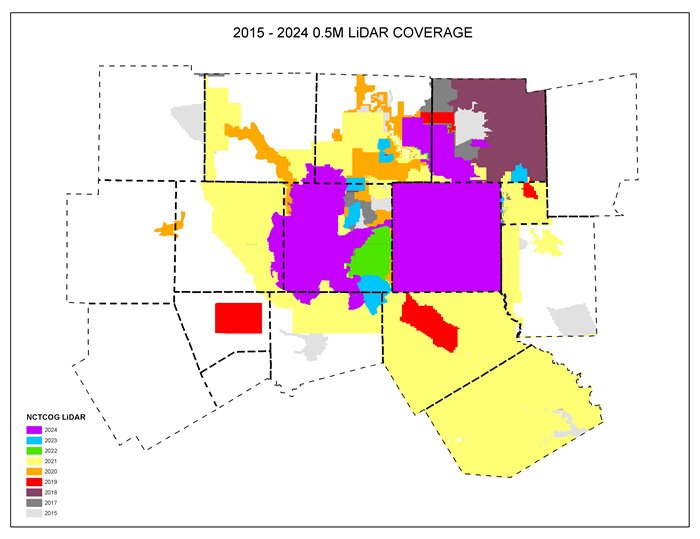LiDAR
LiDAR (Light Detection and Ranging) is a surveying method that measures distance to a target by illuminating that target with a pulsed laser light, and measuring the reflected pulses with a sensor. Differences in laser return times and wavelengths can then be used to make digital 3D-representations of the target. (Source: Wikipedia)

Since 2001, NCTCOG's RIS Department has coordinated the purchase of LiDAR for interested entities. LiDAR data has a useful life-span of about 3 to 5 years in high-growth areas and 7 years in rural areas. The data are being used to create derivative projects like topographic contours, impervious surface analysis, change detection and 3D planimetrics.
NCTCOG has contracted with a vendor to acquire LiDAR each year for any entity that is interested in purchasing it through the Spatial Data Cooperative Program. For this reason, the scope of the project changes each year.
0.35 Meter LiDAR
Starting in 2025, NCTCOG will begin collecting 0.35M LiDAR. This highly accurate LiDAR is collected at a density sufficient to support a nominal pulse spacing of 0.35 meters or less (i.e., with no less than 8 or more points per square meter) to meet USGS QL1 specifications. NCTCOG LiDAR, which includes hydrologic breaklines, is delivered in a LAS format using the ASPRS LAS format 1.2 specifications and is classified according to the table below.
| Class 1 | Default/unclassified |
| Class 2 | Bare earth |
| Class 3 | Low vegetation |
| Class 4 | Medium vegetation |
| Class 5 | High vegetation |
| Class 6 | Buildings (98%) |
| Class 7 | All noise |
| Class 9 | Water |
| Class 17 | Overlap default/unclassified |
| Class 18 | Overlap ground |
0.5 Meter LiDAR
NCTCOG collected 0.5M LiDAR from 2015 to 2024. This LiDAR is collected at a density sufficient to support a nominal pulse spacing of 0.5 meters or less (i.e., with no less than 4 or more points per square meter) to meet USGS QL2 specifications. NCTCOG LiDAR, which includes hydrologic breaklines, is delivered in a LAS format using the ASPRS LAS format 1.2 specifications.
0.5 meter LiDAR datasets may be viewed and printed from DFWMaps and purchased in digital format through the DFWMaps Marketplace.
Sample 0.5M LiDAR File (LAS format)
USGS LiDAR Quality Level Requirements
(source: USGS)
| QUALITY LEVEL | DATA SOURCE | VERTICAL ACCURACY RMSEz (cm) | NOMINAL PULSE SPACING (NPS) meters | NOMINAL PULSE DENSITY (NPD) points per square meter | DIGITAL ELEVATION MODEL (DEM) cell size (meters) |
|---|---|---|---|---|---|
| QL0 | Lidar | 5 cm | <= 0.35 m | >= 8 pts/square meter | 0.5 m |
| QL1 | Lidar | 10 cm | <= 0.35 m | >= 8 pts/square meter | 0.5 m |
| QL2 | Lidar | 10 cm | <= 0.71 m | >= 2 pts/square meter | 1 m |
| QL3 | Lidar | 20 cm | <= 1.41 m | >= 0.5 pts/square meter | 2m |
| QL4 | Imagery | 139 cm | N/A | N/A | 5 m |
| QL5 | IfSAR | 185 cm | N/A | N/A | 5 m |
For more information on LiDAR, visit the SDCP FAQ page or send us an email.
